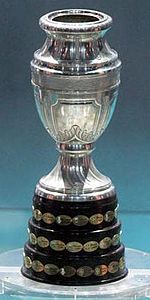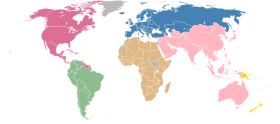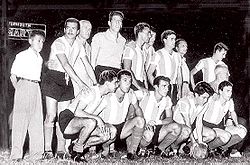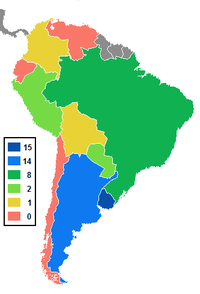- Copa América
-
"Copa America" redirects here. For other uses, see Copa America (disambiguation).
Copa América 
Founded 1916 (South American Championship)
1975 (Copa América)Region South America (CONMEBOL) Number of teams 12 Current champions  Uruguay (15th title)
Uruguay (15th title)Most successful team  Uruguay (15 titles)
Uruguay (15 titles)Website ca2011.com  2011 Copa América
2011 Copa AméricaThe Copa América (Spanish and Portuguese for "America Cup")—previously known as South American Championship—is an international football competition contested between the men's national teams of CONMEBOL, the sport's continental governing body. It is the oldest international continental football competition.
The current tournament format involves twelve teams competing at venues in a host nation over a period of about a month. The confederation has only ten members, so national teams from other FIFA confederations are invited to fill the other 2 places; Mexico, Costa Rica and the United States have been regular since being invited for the first time in 1993. In 43 tournaments, seven national teams have won the title. Uruguay is the current champion and the most successful team in the tournament, having won it fifteen times.
The Copa América is one of the world's most widely viewed sporting events. The highest finishing member of CONMEBOL has the right to participate in the next edition of the FIFA Confederations Cup, but is not obligated to do so.[1]
Contents
History
Beginnings
The first recorded association football match in South America was played in Argentina in 1867 by British railway workers. The first association football team in South America, Gimnasia y Esgrima de La Plata was created in Argentina in 1887, and the Argentine Football Association was founded in 1893. By the early 20th century, football was growing in popularity, and the first international competition held between national teams of the continent occurred in 1910 when Argentina organized an event to commemorate the centenary of the May Revolution. Chile and Uruguay participated, but this event is not considered official by CONMEBOL. Similarly, for the centennial celebration of its independence, Argentina held a tournament between July 2 and July 17 of 1916 with Argentina, Chile, Uruguay and Brazil being the first participants of the tournament. This so-called Campeonato Sudamericano de Selecciones would be the first edition of what is currently known as Copa América; Uruguay would triumph in this first edition after tying 0-0 with hosts Argentina in the deciding, last match held in Estadio Racing Club in Avellaneda.
 Uruguay won the first two South American Championships, the first held in Buenos Aires in 1916 and the second in 1917, in Montevideo.
Uruguay won the first two South American Championships, the first held in Buenos Aires in 1916 and the second in 1917, in Montevideo.
Seeing the success of the tournament, a boardmember of the Asociación Uruguaya de Fútbol or Uruguayan Football Association, Héctor Rivadavia, proposed the establishment of a confederation of the associations of Argentina, Brazil, Chile and Uruguay, and on July 9, independence day in Argentina, CONMEBOL was founded. The following year, the competition was played again, this time in Uruguay. Uruguay would win the title again to win their bicampeonato after defeating Argentina 1-0 in the last match of the tournament. The success of the tournament on Charrúan soil would help consolidate the tournament. After a flu outbreak in Rio de Janeiro canceled the tournament in 1918, Brazil hosted the tournament in 1919 and was crowned champion for the first time after defeating the defending champions 1-0 in a playoff match to decide the title, while the Chilean city of Viña del Mar would host the 1920 event which was won by Uruguay.
For the 1921 event, Paraguay participated for the first time after its football association affiliated to CONMEBOL earlier that same year. Argentina won the competition for the first time thanks to the goals of Julio Libonatti. In subsequent years, Uruguay would dominate the tournament, which at that time was the largest football tournament in the world. Argentina, however, would not be far behind and disputed the supremacy with the Charruas. After losing the 1928 final at the 1928 Summer Olympics held in Amsterdam, Argentina would gain revenge in the 1929 South American Championship by defeating the Uruguayans in the last, decisive match. During this period, both Bolivia and Peru debuted in the tournament in 1926 and 1927, respectively.
Disorganization and intermittency
After the first World Cup held in Uruguay in 1930, the enmity between the football federations of Uruguay and Argentina prevented the competition from being played for a number of years. Only in 1935 was it possible to dispute a special edition of the event to be officially reinstated in 1939. Peru became the host nation of the 1939 edition and won the competition for the first time ever after a 2-1 victory over Uruguay. Ecuador made their debut at that tournament.
In 1941, Chile hosted that year's edition in celebration of the 400th anniversary of the founding of Santiago for which the capacity of the newly built Estadio Nacional was expanded from 30,000 to 70,000 spectators. Despite the large investment and initial success of the team, the Chileans would be defeated in the last match by eventual champions Argentina. Uruguay hosted and won the 1942 edition. Chile would host again in 1945 only to come agonizingly close to disputing the title with Argentina only for Brazil to spoil the possibility; Argentina would win the tournament once again on Chilean soil.
The event entered a period of great disruption. The championship was not played on a regular basis and many editions would be deemed unofficial, only to be considered valid later on by CONMEBOL. For example, Argentina would be the first (and so far only) team to win three consecutive titles by winning the championships of 1945, 1946 and 1947. After those three annual tournaments, the competition returned to being held every two years, then three and later four. There were even two tournaments held in 1959, one in Argentina and a second in Ecuador. During this period, some of the national teams were indifferent to the tournament. Some did not participate every year, others sent lesser teams; in the 1959 edition held in Ecuador, Brazil entered a team from the state of Pernambuco. Bolivia won for the first time when it hosted in 1963, but was defeated in the first game of the 1967 tournament by debutant Venezuela. The founding of the Copa Libertadores in 1959 also affected the way the tournament was viewed by its participants.
After eight years of absence, the event resumed in 1975 and officially acquired the name Copa América. The tournament had no fixed venue, and all matches were played throughout the year in each country. Nine teams participated in the group stages with the defending champions receiving a bye into the semifinals. The tournament was contested every four years using this system until 1987.
Renewal
See also: Copa América FinalsIn 1986, CONMEBOL decided to return to having one country host the tournament and to dispute it every other year. From 1987 until 2001, the event was hosted every two years in rotation by the ten members of the confederation. The format would remain constant with a first round of groups, but the final round stage ranged from being a new, final round-robin group or a single-elimination system to decide the winner. This renewal helped the tournament, which began television coverage in Europe and North America. The 1987 Copa América was held in Argentina; this was the first time the nation had hosted an edition in 28 years. Despite entering as heavy favorites for being the reigning world champions (having won the 1986 FIFA World Cup), playing at home and having a team largely composed of its World Cup winners led by the legendary Diego Maradona, Argentina would finish in a disappointing fourth place after being beaten by defending champions Uruguay 0-1 in the semifinals. Uruguay would defeat a surprisingly strong Chilean squad who made it to the final, disposing of the powerful Brazil 4-0 on the group stage.
Brazil lifted its first official international title since the 1970 FIFA World Cup after winning the 1989 Copa América held on home soil. Argentina, in turn, won the Copa América after 32 long years in 1991 in Chile, thanks to a refreshed squad led by the prolific goalscorer Gabriel Batistuta. The 1993 Copa América tournament in Ecuador would take its current form. Along with the usual ten teams, CONMEBOL invited two countries from CONCACAF to participate, Mexico and the United States.
Uruguay managed to win, as host, the competition in 1995 ending a period of decline for Uruguayan football. With the implementation of rotating hosts, Colombia, Paraguay and Venezuela hosted the tournament for the first time. Brazil entered a successful series of victories, winning four of the five continental titles between 1997 and 2007. The first, in 1997, was won after defeating host nation Bolivia 1-3 with goals from Leonardo, Denílson and Ronaldo becoming crucial in the Verde-Amarela's consagration on Bolivia's altitude. Brazil will successfully defend the title in 1999 after thumping Uruguay 3-0 in Asuncion, Paraguay. However, the 2001 Copa América saw one of the biggest surprises of the history of the sport as Honduras eliminated Brazil in the quarterfinals. Colombia, the host nation, would go on to win the competition for the first time ever.
Ruing from the embarrassing performance in 2001, Brazil reestablished itself in the South American pantheon after defeating Argentina, on penalties, in order to win the 2004 competition held in Peru. Three years later, the two teams met again in the final, this time in Venezuela. Once again, Brazil came out victorious after crushing Argentina 3-0.
Argentina hosted the 2011 competition and was ousted by Uruguay in the quarterfinals by penalty shootout. Uruguay would go on defeating Peru 2-0 in the semis to reach the finals and overpower Paraguay 3-0, thus winning the trophy on Argentinean soil for the third time and second in a row.
Hosts
In 1984, CONMEBOL adopted the policy of rotating the right to host the Copa América amongst the ten member confederations. The first rotation has now been completed following the 2007 Copa América which took place in Venezuela. A second rotation has been agreed to begin in 2011, with host countries rotating in alphabetical order, starting with Argentina.[2] Chile, México and the United States expressed interest in hosting the next tournament, but the CONMEBOL Executive Committee decided to continue the execution of the rotation, giving priority of the organization to each of its member associations; each association confirms whether they will host an edition or not, having no obligation to do so. Argentina confirmed on November 24, 2008, via representatives of the Argentine Football Association, that it would host the 2011 Copa América.
The 2015 Copa América was due to be held in Brazil following the order of rotation. However, the hosting of the 2014 FIFA World Cup and the 2016 Summer Olympics in that nation resulted in the decision being reconsidered. Although CONMEBOL President Nicolas Leoz proposed hosting the continental tournament in Mexico (a member of the CONCACAF federation) and board members Brazil and Chile discussed the possibility of exchanging the 2015 and 2019 tournaments, it was decided in the end, as the CBF confirmed in February 2011, that the 2015 Copa América is to be held in Brazil.
Each Copa América since 1987 has its own mascot or logo. Gardelito, the mascot for the 1987 competition, was the first Copa América mascot.
Times hosted Hosts Editions 9  Argentina (1916, 1921, 1925, 1929, 1937, 1946, 1959, 1987, 2011)
Argentina (1916, 1921, 1925, 1929, 1937, 1946, 1959, 1987, 2011)7  Uruguay (1917, 1923, 1924, 1942, 1956, 1967, 1995)
Uruguay (1917, 1923, 1924, 1942, 1956, 1967, 1995)6  Chile (1920, 1926, 1941, 1945, 1955, 1991)
Chile (1920, 1926, 1941, 1945, 1955, 1991)
 Peru (1927, 1935, 1939, 1953, 1957, 2004)
Peru (1927, 1935, 1939, 1953, 1957, 2004)4  Brazil (1919, 1922, 1949, 1989)
Brazil (1919, 1922, 1949, 1989)3  Ecuador (1947, 1959, 1993)
Ecuador (1947, 1959, 1993)2  Bolivia (1963, 1997)
Bolivia (1963, 1997)1  Colombia (2001)
Colombia (2001)
 Paraguay (1999)
Paraguay (1999)
 Venezuela (2007)
Venezuela (2007)3 No fixed host [F] (1975, 1979, 1983) Format and rules
The tournament was previously known as sup Campeonato Sudamericano de Selecciones (South American Championship of National Teams). South American Championship of Nations was the official English language name. The current name has been used since 1975. Between 1975 and 1983 it had no host nation, and was held in a home and away fashion. The current final tournament features 12 national teams competing over a month in the host nation. There are two stages: the group stage followed by the knockout stage. In the group stage, teams compete within three groups of four teams each. Three teams are seeded, including the hosts, with the other seeded teams selected using a formula based on the FIFA World Rankings. The other teams are assigned to different "pots", usually based also on the FIFA Rankings, and teams in each pot are drawn at random to the three groups.
Each group plays a round-robin tournament, in which each team is scheduled for three matches against other teams in the same group. The last round of matches of each group is not scheduled at the same time unlike many tournaments around the world. The top two teams from each group advance to the knockout stage as well as the two best third-place teams. Points are used to rank the teams within a group. Beginning in 1995, three points have been awarded for a win, one for a draw and none for a loss (before, winners received two points).
The ranking of each team in each group will be determined as follows:
- a) greatest number of points obtained in all group matches;
- b) goal difference in all group matches;
- c) greatest number of goals scored in all group matches.
If two or more teams are equal on the basis of the above three criteria, their rankings will be determined as follows:
- d) greatest number of points obtained in the group matches between the teams concerned;
- e) goal difference resulting from the group matches between the teams concerned;
- f) greater number of goals scored in all group matches between the teams concerned;
- g) drawing of lots by the CONMEBOL Organising Committee (i.e. at random).
The knockout stage is a single-elimination tournament in which teams play each other in one-off matches, with penalty shootouts used to decide the winner if a match is still tied after extra time. It begins with the quarter-finals, then semi-finals, the third-place match (contested by the losing semi-finalists), and the final.
Invitees
Since 1993, two teams from other confederations, usually from CONCACAF whose members are geographically and culturally close, are also invited. In all, seven different nations have received invitations. Nations receiving invitations are Costa Rica (1997, 2001, 2004, 2011), Honduras (2001), Japan (1999, 2011, 2015), Mexico (1993, 1995, 1997, 1999, 2001, 2004, 2007, 2011), and the United States (1993, 1995, 2007). The United States had been invited every time from 1997 to 2007 but frequently turned down the invitation due to scheduling conflicts with Major League Soccer. However, on October 30, 2006, the US Soccer Federation accepted the invitation for participation in the 2007 tournament, ending a 12 year absence. At the 2001 Copa América, Canada was an invitee, but on July 6, 2001 withdrew because of security concerns. At the 2011 Copa América, Japan withdrew, citing difficulties with European clubs in releasing Japanese players.[3] South American football's governing body CONMEBOL has stated that Japan would be invited to the 2015 Copa América.[4] Spain was invited to the 2011 edition, but according to the Royal Spanish Football Federation, they declined because they did not want to interrupt the Spanish players' holidays.[5]
Invitees nations record
Team 
1993
1995
1997
1999
2001
2004
2007
2011Editions  Canada
Canada- - - - w/d - - - 0  Costa Rica
Costa Rica- - GS - QF QF - GS 4  Honduras
Honduras- - - - 3rd - - - 1  Japan
Japan- - - GS - - - w/d 1  Mexico
Mexico2nd QF 3rd 3rd 2nd QF 3rd GS 8  United States
United StatesGS 4th - - - - GS - 3 Trophies
Two trophies are awarded at the end of the competition: the Copa América is given to the winner, while the Copa Bolivia is awarded to the runner-up. The Copa América trophy, which is awarded to the winner of the Copa América tournament, was donated to CONMEBOL by the Ministry of Foreign Affairs of Argentina in 1916. The prestigious laurel was obtained from a jewelry shop in Buenos Aires at the cost of 3,000 Swiss francs. The trophy is a silver ornament with wooden base which contains several plaques. The plaques are engraved with every winner of the competition, as well as the edition won.
Results
South American Championship era
Copa América era
- Key:
- Invited teams in italics
- pens – after penalty shootout
Given the size of the confederation (it is the smallest with only ten members), every nation has been represented in the tournament. Recently, invitees from outside CONMEBOL have taken part in the competition in order to provide a more viable format to the competition. Seven nations have won the Copa América, only five have won it more than once and only three more than twice. With 15 titles Uruguay is the most successful Copa América team, while Argentina is second with 14 titles. 12 of Argentina's titles and 10 of Uruguay's were won before 1960. Brazil have won it eight times with half of those titles being won after 1989. Argentina has made the most appearances in the final, with 26, and on the podium, with 30, while Uruguay have made the most appearances in the top four, with 35.
Argentina, Uruguay, Brazil and Paraguay are the only teams able to win the Copa América outside their countries. Argentina won it eight times outside its country, Uruguay seven times, Brazil four times and Paraguay just once. Colombia and Bolivia have only won the Copa América as hosts (this does not take into account the Copa América tournaments held under a home and away format from 1975 to 1983). Uruguay and Brazil are the most successful teams as hosts winning all editions held in their country (Uruguay 7 times and Brazil 4). Uruguay is the only foreign team to have won the title in Argentina and did so 3 times out of the 9 held there. Chile is the most unsuccessful host nation being unable to win in any of the 6 tournaments held there, the last 4 of which were won by Argentina. Only Uruguay, Argentina and Brazil have won consecutive Copa Américas while Argentina is the only team to win it three times in a row. Mexico, who is from the CONCACAF, has had some success, being runner-up twice and third place on several occasions.
Teams reaching the top four
Team Titles Runner-up Third place Fourth place  Uruguay
Uruguay15 (1916, 1917*, 1920, 1923*, 1924*, 1926, 1935, 1942*, 1956*, 1959 (Ecuador), 1967*, 1983, 1987, 1995*, 2011) 6 (1919, 1927, 1939, 1941, 1989, 1999) 9 (1921, 1922, 1929, 1937, 1947, 1953, 1957, 1975, 2004) 5 (1945, 1946, 1955, 2001, 2007)  Argentina
Argentina14 (1921*, 1925*, 1927, 1929*, 1937*, 1941, 1945, 1946*, 1947, 1955, 1957, 1959 (Argentina)*, 1991, 1993) 12 (1916*, 1917, 1920, 1923, 1924, 1926, 1935, 1942, 1959 (Ecuador), 1967, 2004, 2007) 4 (1919, 1956, 1963, 1989) 2 (1922, 1987*)  Brazil
Brazil8 (1919*, 1922*, 1949*, 1989*, 1997, 1999, 2004, 2007) 11 (1921, 1925, 1937, 1945, 1946, 1953, 1957, 1959 (Argentina), 1983, 1991, 1995) 7 (1916, 1917, 1920, 1942, 1959 (Ecuador), 1975, 1979) 3 (1923, 1956, 1963)  Paraguay
Paraguay2 (1953, 1979) 6 (1922, 1929, 1947, 1949, 1963, 2011) 7 (1923, 1924, 1925, 1939, 1946, 1959 (Argentina), 1983) 6 (1921, 1926, 1937, 1942, 1967, 1989)  Peru
Peru2 (1939*, 1975) — 7 (1927*, 1935*, 1949, 1955, 1979, 1983, 2011) 5 (1929, 1941, 1957*, 1959 (Argentina), 1997)  Colombia
Colombia1 (2001*) 1 (1975) 3 (1987, 1993, 1995) 2 (1991, 2004)  Bolivia
Bolivia1 (1963*) 1 (1997*) — 2 (1927, 1949)  Chile
Chile— 4 (1955*, 1956, 1979, 1987) 5 (1926*, 1941, 1945, 1967, 1991*) 10 (1916, 1917, 1919, 1920*, 1924, 1935, 1939, 1947, 1953, 1999)  Mexico^
Mexico^— 2 (1993, 2001) 3 (1997, 1999, 2007) —  Honduras^
Honduras^— — 1 (2001) —  Ecuador
Ecuador— — — 2 (1959 (Ecuador)*, 1993*)  United States^
United States^— — — 1 (1995)  Venezuela
Venezuela— — — 1 (2011) -
*=hosts
-
^=invitees
1993 is the only edition when neither Brazil nor Uruguay has finished in the top four. There have been only 3 editions where neither Argentina nor Brazil has finished in the top four (1939, 2001, 2011). Likewise, only 3 editions have seen neither Argentina nor Uruguay finish in the top four (1949, 1979, 1997). There has never been an edition in which none of the three countries Uruguay, Argentina, and Brazil made it to the top four.
General statistics
Team Po Pl W D L GF GA GD 1  Argentina
Argentina364 173 111 31 31 422 166 +256 2  Uruguay
Uruguay339 184 103 30 51 384 208 +176 3  Brazil
Brazil315 167 95 30 42 387 190 +197 4  Paraguay
Paraguay213 153 61 30 62 241 270 -29 5  Chile
Chile188 161 54 26 81 247 291 -44 6  Peru
Peru169 132 46 31 55 193 220 -27 7  Colombia
Colombia128 99 36 20 43 120 175 -55 8  Bolivia
Bolivia81 102 19 24 59 97 257 -160 9  Mexico
Mexico61 38 17 10 11 55 44 +11 10  Ecuador
Ecuador61 108 14 19 75 114 296 -182 11  Venezuela
Venezuela15 49 4 9 38 36 155 -120 12  Costa Rica
Costa Rica11 11 3 2 6 12 21 -9 13  Honduras
Honduras10 6 3 1 2 7 5 +2 14  United States
United States8 12 2 2 8 11 21 -10 15  Japan
Japan1 3 0 1 2 3 8 -5 Copa América player of the tournament
Year Player 1916  Isabelino Gradín
Isabelino Gradín1917  Héctor Scarone
Héctor Scarone1919  Arthur Friedenreich
Arthur Friedenreich1920  José Piendibene
José Piendibene1921  Américo Tesoriere
Américo Tesoriere1922  Agostinho Fortes Filho
Agostinho Fortes Filho1923  José Nasazzi
José Nasazzi1924  Pedro Petrone
Pedro Petrone1925  Manuel Seoane
Manuel Seoane1926  José Leandro Andrade
José Leandro Andrade1927  Manuel Seoane
Manuel Seoane1929  Manuel Ferreira
Manuel Ferreira1935  José Nasazzi
José Nasazzi1937  Vicente De la Mata
Vicente De la Mata1939  Teodoro Fernández
Teodoro Fernández1941  Sergio Livingstone
Sergio Livingstone1942  Obdulio Varela
Obdulio Varela1945  Domingos da Guia
Domingos da Guia1946  Adolfo Pedernera
Adolfo Pedernera1947  José Manuel Moreno
José Manuel Moreno1949  Ademir Menezes
Ademir Menezes1953  Heriberto Herrera
Heriberto Herrera1955  Enrique Hormazábal
Enrique Hormazábal1956  Oscar Míguez
Oscar Míguez1957  Enrique Sívori
Enrique Sívori1959 (Argentina)  Pelé
Pelé1959 (Ecuador)  Alcides Silveira
Alcides Silveira1963  Ramiro Blacut
Ramiro Blacut1967  Pedro Rocha
Pedro Rocha1975  Teófilo Cubillas
Teófilo Cubillas1979  Carlos Caszely
Carlos Caszely1983  Enzo Francéscoli
Enzo Francéscoli1987  Carlos Valderrama
Carlos Valderrama1989  Ruben Sosa
Ruben Sosa1991  Leonardo Rodríguez
Leonardo Rodríguez1993  Sergio Goycochea
Sergio Goycochea1995  Enzo Francéscoli
Enzo Francéscoli1997  Ronaldo
Ronaldo1999  Rivaldo
Rivaldo2001  Amado Guevara
Amado Guevara2004  Adriano
Adriano2007  Robinho
Robinho2011  Luis Suárez
Luis SuárezCopa América winning managers
See also
References
- ^ 2005/2006 season: final worldwide matchday to be 14 May 2006; FIFA.com; 19 December 2004.
- ^ Copa America: a new cycle begins and the revolving calendar remains
- ^ "Copa América Argentina 2011: Japón comunicó que no participará del torneo [Copa America Argentine 2011: Japan announced that they will not participate in the tournament]". CONMEBOL. May 16, 2011. http://www.conmebol.com/copaamerica/-Copa-America-Argentina-2011-Japon-comunico-que-no-participara-del-torneo-20110516-0009.html. Retrieved May 16, 2011.
- ^ [1]
- ^ http://www.lagaceta.com.ar/nota/431027/Deportes/Japon-Copa-America.html
Footnotes
- A. ^ Only three teams entered the tournament.
- B. ^ No third place match was played; third place was shared.
- C. ^ There was no trophy being competed for in the 1916 tournament. It was competed for the first time in the 1917 tournament.
- D. ^ The tournament was an extra edition, with no trophy handed to the winners, but considered official by CONMEBOL.
- E. ^ Final stage was a round-robin group.
- F. ^ Matches were played in "Home - Away" basis.
External links
- The Copa América Archive - Trivia
- RSSSF archive - includes extensive match reports.
Copa América Tournaments Argentina 1916 · Uruguay 1917 · Brazil 1919 · Chile 1920 · Argentina 1921 · Brazil 1922 · Uruguay 1923 · Uruguay 1924 · Argentina 1925 · Chile 1926 · Peru 1927 · Argentina 1929 · Peru 1935 · Argentina 1937 · Peru 1939 · Chile 1941 · Uruguay 1942 · Chile 1945 · Argentina 1946 · Ecuador 1947 · Brazil 1949 · Peru 1953 · Chile 1955 · Uruguay 1956 · Peru 1957 · 1959 (Argentina · Ecuador) · Bolivia 1963 · Uruguay 1967 · 1975 (No fixed venue) · 1979 (No fixed venue) · 1983 (No fixed venue) · Argentina 1987 · Brazil 1989 · Chile 1991 · Ecuador 1993 · Uruguay 1995 · Bolivia 1997 · Paraguay 1999 · Colombia 2001 · Peru 2004 · Venezuela 2007 · Argentina 2011 · Brazil 2015Finals 1975 · 1979 · 1983 · 1987 · 1989 · 1991 · 1993 · 1995 · 1997 · 1999 · 2001 · 2004 · 2007 · 2011Squads Copa Centenario Revolución de Mayo · Goalscorers · Hat-tricks · Mascots · Records Football in South America (CONMEBOL)  Argentina (AFA)National team · Women's national team · Under-20 National team · Under-17 National team · Primera División · Copa Argentina
Argentina (AFA)National team · Women's national team · Under-20 National team · Under-17 National team · Primera División · Copa Argentina Bolivia (FBF)National team · Women's national team · Under-20 National team · Under-17 National team · Liga de Fútbol Profesional · Copa Aerosur
Bolivia (FBF)National team · Women's national team · Under-20 National team · Under-17 National team · Liga de Fútbol Profesional · Copa Aerosur Brazil (CBF)National team · Women's national team · Under-20 National team · Under-17 National team · Série A · Copa do Brasil
Brazil (CBF)National team · Women's national team · Under-20 National team · Under-17 National team · Série A · Copa do Brasil Chile (FFC)
Chile (FFC) Colombia (FCF)
Colombia (FCF) Ecuador (FEF)
Ecuador (FEF) Paraguay (APF)National team · Women's national team · Under-20 National team · Under-17 National team · Primera División
Paraguay (APF)National team · Women's national team · Under-20 National team · Under-17 National team · Primera División Peru (FPF)National team · Women's national team · Under-20 National team · Under-17 National team · Primera División
Peru (FPF)National team · Women's national team · Under-20 National team · Under-17 National team · Primera División Uruguay (AUF)National team · Women's national team · Under-20 National team · Under-17 National team · Primera División
Uruguay (AUF)National team · Women's national team · Under-20 National team · Under-17 National team · Primera División Venezuela (FVF)National team · Women's national team · Under-20 National team · Under-17 National team · Primera División · Copa Venezuela
Venezuela (FVF)National team · Women's national team · Under-20 National team · Under-17 National team · Primera División · Copa VenezuelaNational team competitions MenCopa América · Under-20 Football Championship · Under-17 Football Championship · Under-15 Football Championship · Pan-American Games · Superclásico de las AméricasWomenWomen's Football Championship · Under-20 Women's Football Championship · Under-17 Women's Football ChampionshipClub competitions CurrentCopa Libertadores · Copa Sudamericana · Recopa Sudamericana · Copa Suruga Bank · Copa Libertadores de Fútbol Femenino · Under-20 Copa LibertadoresDefunctIntercontinental Cup · Copa Iberoamericana · Copa CONMEBOL · Copa Mercosur · Copa Merconorte · Supercopa Sudamericana · Supercopa Masters · Copa de Oro · Copa Masters CONMEBOL · Copa Ganadores de Copa · Campeonato Sudamericano de Campeones · Copa Río de La PlataSouth American Footballer of the Year · South American Coach of the Year · South American Best 11 · Top-division clubs · Club competition winning teams · Club competition winning managers International association football FIFA · World Cup · Confederations Cup · U-20 World Cup · U-17 World Cup · Olympics · Minor tournaments · World Rankings · Player of the Year · FIFA Ballon d'Or · Teams · Debuts · Competitions · Federations · Codes Asia 
Africa North,
Central America
and CaribbeanSouth America CONMEBOL – Copa AméricaOceania Europe Non-FIFA Games All-Africa Games · Asian Games · CARIFTA Games · East Asian Games · Francophonie Games · IOIG · Lusophony Games · Mediterranean Games · Pan American Games · Pan Arab Games · Pacific Games · South Asian Games · Southeast Asian GamesSee also International women's football. Categories:- Copa América
- CONMEBOL competitions
Wikimedia Foundation. 2010.




